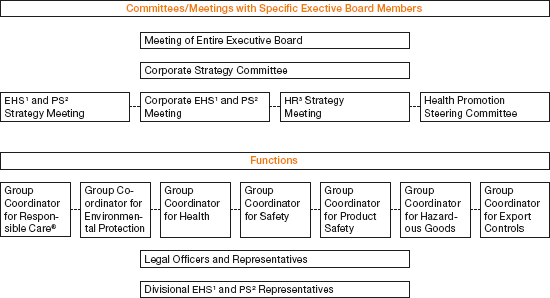Wacker Chemie AG’s four-member Executive Board oversees the Group’s strategies, resources, infrastructure and organizational structure. President and CEO Dr. Rudolf Staudigl heads the Board. The other members are Dr. Joachim Rauhut, Dr. Wilhelm Sittenthaler and Auguste Willems. An Executive Board Meeting is WACKER’s highest decision-making authority. Below the Executive Board, there are various committees whose membership spans several organizational sectors and legal entities. These committees ensure that corporate strategies are implemented groupwide.

1 Environment, Health, Safety
2 Product Safety
3 Human Resources
The Corporate Strategy Committee (KUS), for example, deliberates on strategically important processes, potential market or competitor developments, and key special topics not directly related to daily operations. The committee comprises the entire Executive Board, business-division presidents and corporate-department heads.
The main committees for environment, health, safety and product safety are the EHS and PS Strategy Meetings (convened annually) and the Corporate EHS and PS Meetings, each led by the Executive Board member responsible for Site Management. Personnel policies are dealt with monthly by the HR Strategy Group while employee health is addressed once a year by the Health Promotion Steering Committee – both are chaired by WACKER’s personnel director.
The Corporate Sustainability department was founded in 2011. Its task is to manage sustainability activities and initiatives throughout the Group. Outlook.
WACKER has grown over the past years. Our international presence has kept pace with that growth. We have established new production sites and expanded existing ones. In 2009 and 2010, we reviewed our sustainability management structures and processes, adapting them to reflect the company’s increasing level of globalization. To this end, WACKER initiated projects such as “Global EHS & PS Excellence.” This project has helped standardize global management and reporting on the environment and health & safety, and on product safety (EHS & PS), without losing sight of regional requirements. Thus, guidelines and instructions are now implemented by the local heads of WACKER subsidiaries rather than by the various business divisions.

